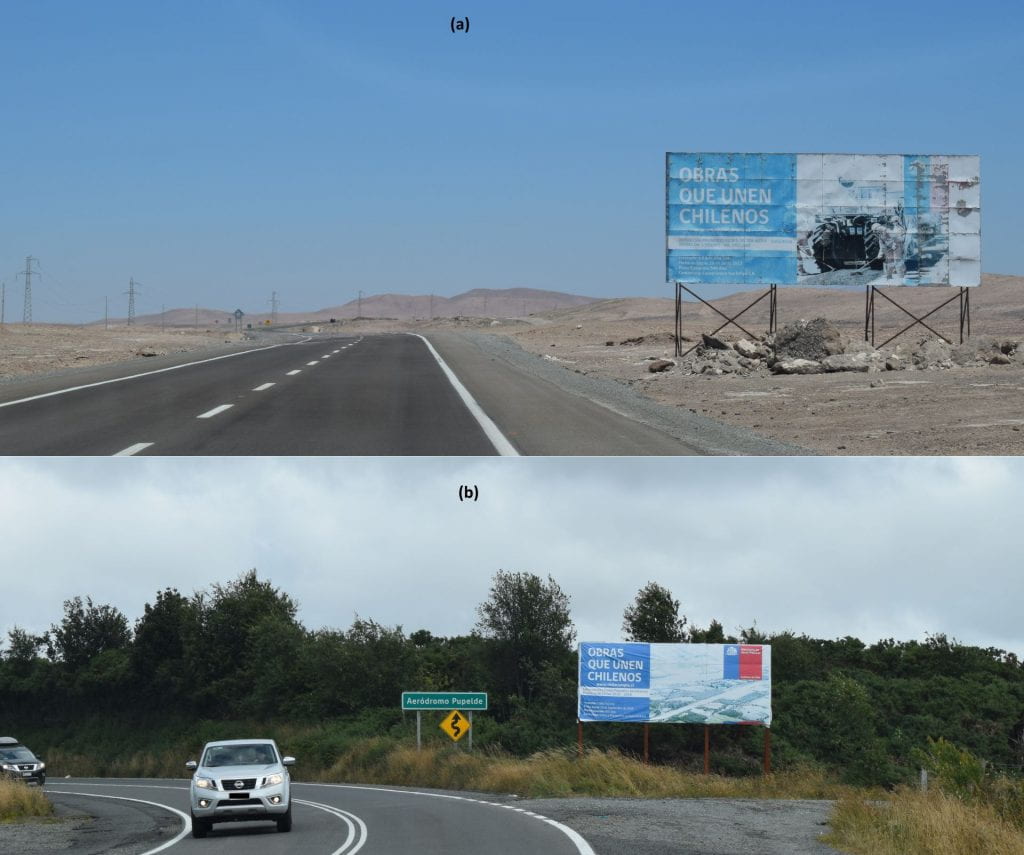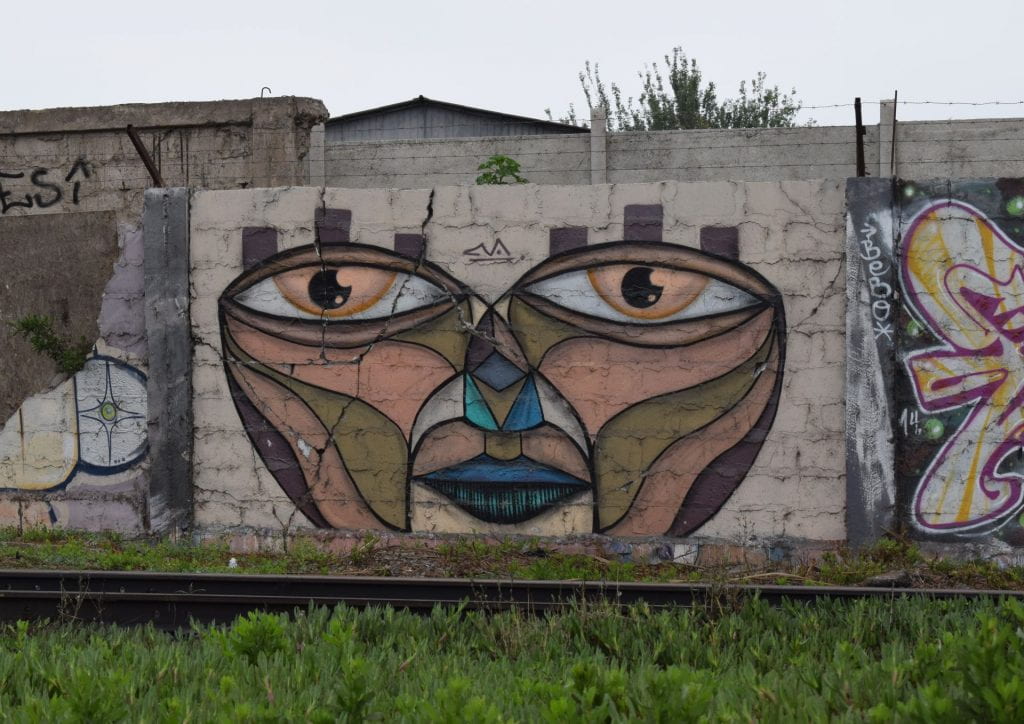By Isidora Urrutia Steinert.
Much is written about mobilities but less about the infrastructures enabling movement. Researchers tend to focus on the political, economic, social and cultural implications of the circulation of people, ideas and things. Roads – as with water pipes or sewage systems – are taken for granted unless they stop working. When we travel, our attention usually centres on our destination, the traffic, service stations or time – not so much on the transport system. Trails, roads and motorways, however, have much to tell.
For the past four years I have been studying Route 5, Chile’s longest motorway, reaching almost four fifths of the length of the country (3,364 km/2,090 miles). It is the Chilean section of the Pan-American Highway. The history of Route 5 since the 1920s and its current materiality have taught me that roads are not straightforward; rather, they embody promises, memories, conflict, interests, power structures and challenges to power.
My research focuses on the multiple and contested imaginaries of national integration that have been part of the history of Route 5 and that are embodied along its roadside today. It shows that divisions between ‘us’ and ‘them’ are not only imagined – as Benedict Anderson claimed four decades ago – but also sensed and experienced in material form in everyday life. And roads, as infrastructures for movement, perform these distinctions. The picture below shows a Ministry of Public Works poster claiming that Route 5 is a ‘work uniting Chileans’ [Obra que une Chilenos] – fostering the government narrative of connectivity as integration. My study shows, however, that Route 5 has long been a site of difference and alterity as much as of unification.

In Chile, as elsewhere, the state has promoted the construction, paving and renovations of Route 5 over the past 100 years as a pathway to achieve a future condition of modernity. As scholars like Walter Mignolo (2000, 2005) and Aníbal Quijano (2007) have clearly stated, however, modernity is inseparable of coloniality – and Route 5 is no exception.
The history of its construction in the 1920s, its paving in the 1950s and its era of neoliberal renovation in the 1990s shows that the state, engineers and construction companies have represented this motorway as a technology of modernity that would lead the rest of the country’s inhabitants from barbarism to civilisation, from tradition to progress, and from underdevelopment to development. In doing so, these elites created a future-oriented national integration narrative – materialised in signposts like the ones shown above – linked to notions of a racial and cultural homogenising through mestizaje (racial and cultural mixture)], which were later reworked as neoliberal multiculturalism. These elite-led discourses, however, resulted in the material and symbolic exclusion of certain groups in terms of class, race/ethnicity, gender and claims of political-autonomy.
Route 5’s roadside tells alternative and often conflicting stories. I carried out fieldwork in 2018, mapping and photographing around 2,500 of its roadside sites. These included mainly animitas – roadside shrines that family and friends construct to commemorate the victim of a tragic death, usually due to a car accident – alongside murals, sculptures, monuments and other shrines devoted to Catholic and folk saints.
These roadside sites show a diverse and vibrant Chile, where peoples and communities contest the dominant discourse of a unified nation in many ways. For instance, whilst National Monuments narrate a history whereby ‘Chileanness’ is represented as the homogenous product of a mixture between an ancient indigenousness and a modern Europeanness, animitas and shrines make visible the resilience of indigenous worldviews and practices throughout the country. They bring the dead into the world of the living, attribute agency to non-human subjects, and disrupt spatial binaries such as the private and the public, or the individual and the collective.
Roadside sites along Route 5 also offer a new lens for the study of identities. The Aymara notion of ch’ixi – an indigenous epistemology – often came to mind in my encounters with these sites. Ch’ixi refers to a colour derived from the juxtaposition of two (or more) contrasting colours, without fusing them. According to Bolivian-Aymara sociologist Silvia Rivera Cusicanqui (2010), this notion ‘obeys the Aymara idea that something is and is not at the same time’ (p. 69), constituting ‘a powerful image to think about the coexistence of heterogeneous elements that do not aspire to fusion and that also do not produce a new, superior, and encompassing term’ (p.7).
For example, the image below shows a mural on Route 5’s roadside in the city of La Serena. By presenting a face made up of different colours that do not mix or fuse into each other, being a mosaic that allows for difference, it is challenging fusion-like and homogenising versions of mestizaje. Contrary to the etymology of the concept of identity, based upon the idea that something cannot both be and not be at the same time, the indigenous concept of ch’ixi allows us to inhabit and accept heterogeneity.

Route 5’s roadside lends itself to this way of thinking, to the ch’ixi weaving that creates a mixture of colours without homogenising them, as a way to resituate identities. In doing so, these sites reclaim places and communities as worthy, offer places of silence and rest in an infrastructure made for movement, and integrate conflict and contradiction in a non-merging manner.
Since the Estallido Social in 2019 – the largest social outburst that Chile has seen since the end of Pinochet’s dictatorship in 1990 – there have been interventions in public spaces throughout the country to make alternative identities visible. But the history and materiality of Route 5 have shown me that these disputes around identity have a much longer history and that they challenge Chile’s narratives of exceptionalism, presenting it instead as part of the wider Latin American region with all its diverse identities.
Route 5, then, does not just enable movement. It embodies a material scar – a reminder and enforcer of modernity’s exclusionist narratives that create and impose hierarchies. It also constitutes a platform for material and epistemic resistance in the constant creation and re-creation of identities. As a tool for modernity/coloniality, it is also used in decolonial ways.

